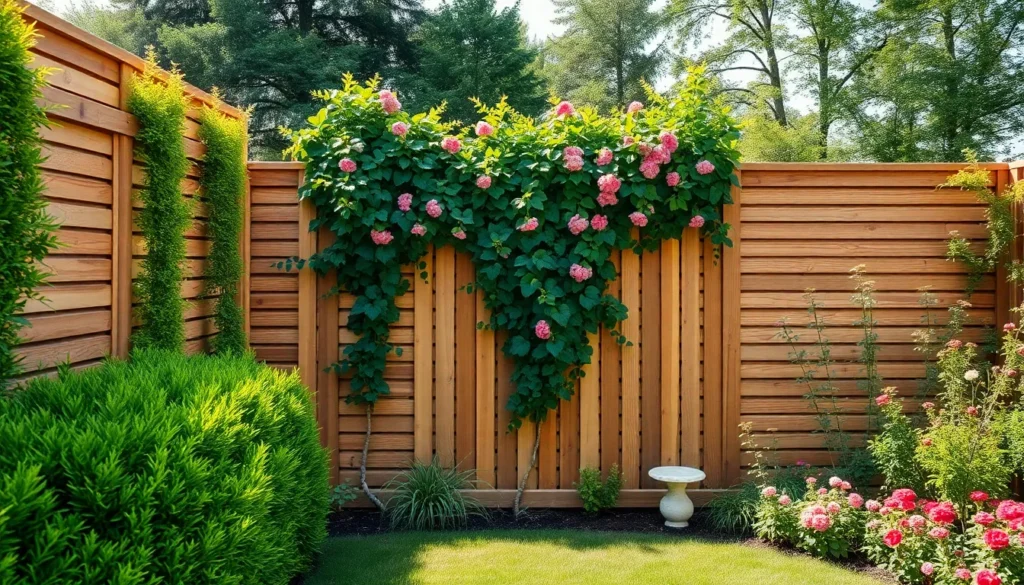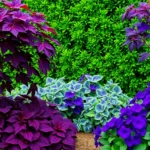We’ve all been there – enjoying our backyard oasis only to catch glimpses of curious neighbors peering over. Privacy fencing transforms your garden into a true sanctuary where you can relax, entertain, and garden without feeling like you’re on display.
The right privacy fence doesn’t just block unwanted views; it creates stunning visual interest and defines your outdoor living space. Whether you’re dealing with close neighbors, busy streets, or simply want to establish clear boundaries, we’ll explore creative answers that blend functionality with style.
From natural living walls to modern composite panels, today’s privacy options go far beyond basic wooden boards. We’ll share innovative ideas that work with any budget, garden size, and aesthetic preference – helping you create the private retreat you’ve always wanted.
Natural Living Fence Ideas for Garden Privacy
Living fences offer an eco-friendly approach to creating garden privacy while adding natural beauty to your outdoor space. These organic barriers grow over time to provide both screening and environmental benefits.
Bamboo Screening Answers
Clumping bamboo varieties create dense privacy screens that reach heights of 8 to 25 feet within 3 to 5 years. We recommend selecting non-invasive species like Bambusa multiplex or Fargesia rufa to avoid unwanted spreading throughout your garden.
Running bamboo types establish faster coverage but require containment barriers to prevent aggressive root expansion. Installing 2-foot deep root barriers around the perimeter keeps these varieties like Phyllostachys nigra contained while maintaining their rapid 6 to 10 foot annual growth.
Container grown bamboo provides instant privacy screening for patios and smaller garden areas. Planting bamboo in large planters or raised beds creates moveable privacy answers that adapt to changing industry needs.
Evergreen Hedge Options
Arborvitae hedges form uniform privacy walls reaching 10 to 15 feet tall with regular pruning maintenance. These needle-bearing evergreens like Thuja occidentalis ‘Emerald Green’ provide year-round screening while tolerating various soil conditions and climate zones.
Boxwood barriers create formal hedge lines between 3 to 8 feet high depending on the cultivar selection. We suggest using Buxus sempervirens for larger privacy screens or Buxus microphylla for compact border hedging that requires minimal upkeep.
Holly varieties offer thorny protection alongside dense foliage coverage throughout all seasons. Japanese holly (Ilex crenata) and American holly (Ilex opaca) establish living fences that deter unwanted visitors while supporting local bird populations.
Fast-Growing Vine Coverage
Climbing roses transform plain fences into fragrant privacy barriers within 2 to 3 growing seasons. Training varieties like ‘Eden’ or ‘Don Juan’ along trellis systems creates 8 to 12 foot screens covered in colorful blooms from spring through fall.
Virginia creeper vines provide rapid coverage reaching 30 to 50 feet with aggressive growing habits. This native climber delivers dense foliage screening during growing months plus stunning red fall color before winter dormancy.
Honeysuckle screening establishes quick privacy coverage while attracting beneficial pollinators to garden spaces. Selecting native species like Lonicera sempervirens avoids invasive varieties while creating fragrant barriers that hummingbirds and butterflies love visiting.
Modern Horizontal Slat Fence Designs
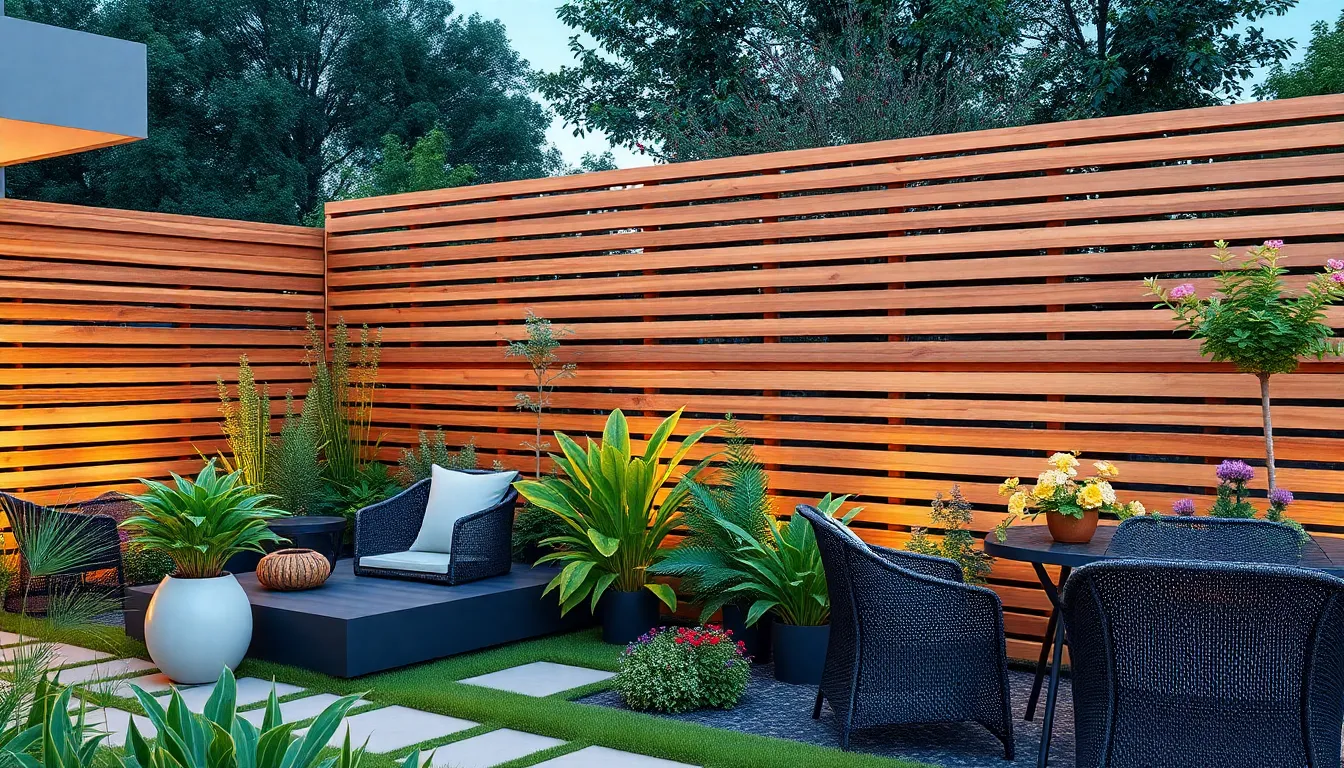
We’re shifting from natural answers to contemporary fence designs that blend privacy with sleek aesthetics. Modern horizontal slat fences offer clean lines and sophisticated styling that complement today’s outdoor living spaces.
Cedar Horizontal Panels
Cedar stands out as our top choice for horizontal slat fencing due to its natural resistance to rot and insects. This durable wood provides a warm, modern look that transforms any garden space into a contemporary retreat. We can stain cedar panels to match any outdoor decor, creating a cohesive design throughout your property.
Benefits include a sleek, contemporary appearance while maintaining complete privacy. The horizontal slats can be spaced strategically to allow some light and airflow, which reduces that closed-in feeling many homeowners want to avoid. Cedar’s natural oils also help preserve the wood’s integrity over time, making it a smart long-term investment for privacy fencing.
Metal and Wood Combinations
Combining the durability of metal with the warmth of wood creates a unique and robust fence structure. This hybrid approach delivers both visual appeal and exceptional strength that withstands harsh weather conditions. We often see steel frames paired with cedar or redwood slats for maximum impact.
Benefits center on providing a strong, weather-resistant structure with a visually appealing contrast between materials. The metal framework ensures stability while wood elements add natural beauty and texture. This combination works particularly well in modern garden designs where architectural elements need to balance industrial and organic aesthetics.
Staggered Slat Patterns
Staggered slat patterns involve arranging slats in an irregular or offset manner, adding important visual interest to standard fence designs. This technique breaks up the monotony of straight lines while creating ever-changing shadows and depth throughout the day. We recommend varying the spacing between slats to achieve the most dramatic effect.
Benefits focus on improving the aesthetic appeal of the fence by creating a ever-changing pattern while maintaining privacy levels. The irregular arrangement catches the eye and adds architectural interest to your garden boundary. Staggered patterns also help reduce wind load on the fence structure, making it more stable in stormy conditions.
Decorative Lattice and Trellis Privacy Options
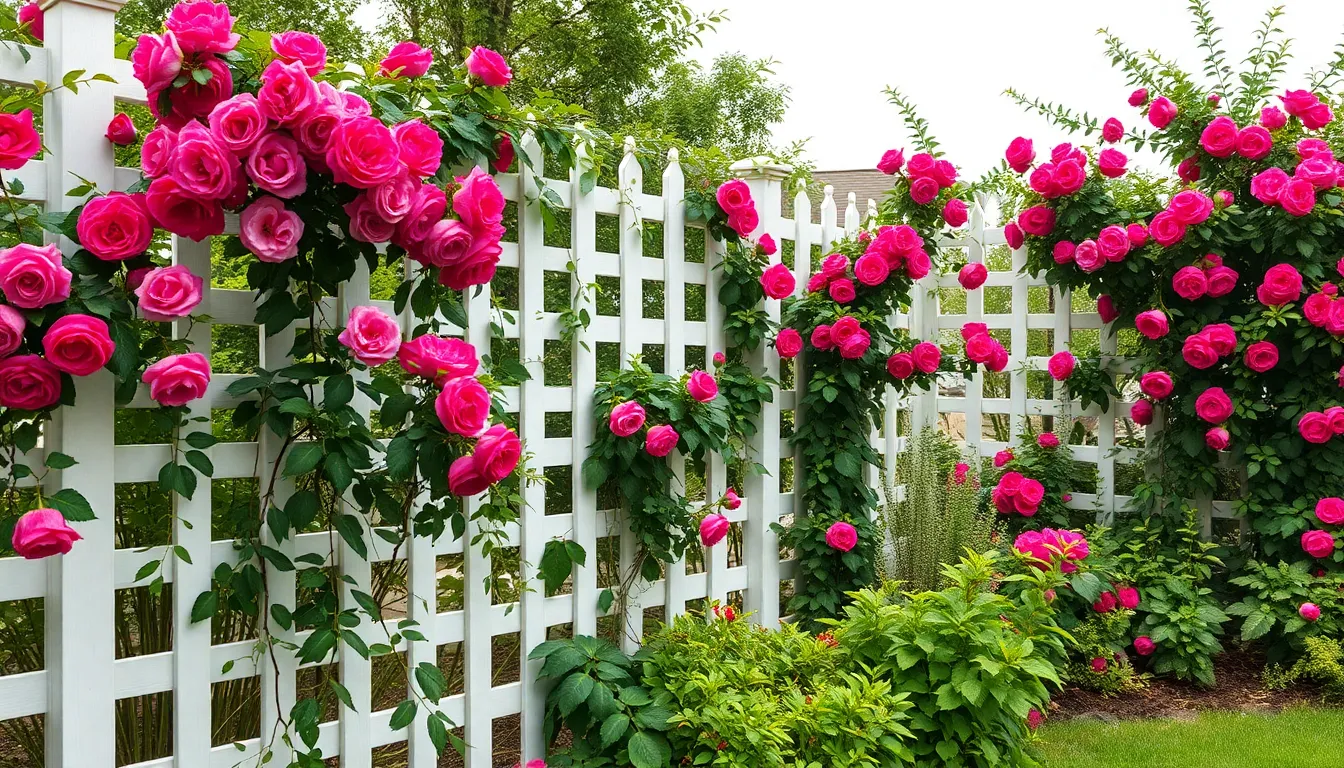
Lattice and trellis fences offer the perfect balance between privacy and openness, creating beautiful garden boundaries that don’t feel overwhelming. These versatile options transform ordinary spaces into intimate retreats while maintaining airflow and natural light throughout your outdoor area.
Vinyl Lattice Panels
Vinyl lattice panels deliver exceptional durability with minimal maintenance requirements, making them ideal for busy homeowners. These panels resist weather damage, fading, and warping unlike traditional wood options. Installation becomes straightforward with pre-manufactured panels that attach directly to pressure-treated posts.
Color options range from classic white to earth tones, allowing seamless integration with existing garden designs. Modern vinyl panels feature various decorative patterns beyond basic diamond shapes, including diagonal squares and curved designs. Longevity extends 15-20 years with proper installation, eliminating the need for annual staining or painting.
Cost effectiveness emerges when comparing long-term maintenance expenses, as vinyl requires only occasional cleaning with soap and water. Weather resistance protects against UV rays, moisture, and temperature fluctuations common in diverse climates.
Custom Wooden Trellis Designs
Custom wooden trellises provide unique architectural elements customized to exact garden spaces and personal preferences. Craftsmen can design intricate patterns that complement your home’s exterior styling while addressing exact height and width requirements. Material choices include cedar, redwood, and pressure-treated pine, each offering distinct aesthetic and durability characteristics.
Design flexibility allows incorporation of geometric patterns, curved elements, or mixed spacing that creates visual interest. Measurements can accommodate narrow side yards, corner installations, or expansive garden boundaries. Professional installation ensures proper post spacing and structural integrity for supporting climbing plants.
Maintenance requirements vary by wood type, with cedar naturally resisting insects and rot while requiring minimal treatment. Customization costs typically range 30-50% higher than pre-fabricated options but deliver personalized results that enhance property value.
Climbing Plant Integration
Climbing plant integration transforms basic lattice structures into living privacy walls that evolve throughout growing seasons. Rose varieties like climbing hybrid teas and ramblers create fragrant barriers while producing colorful blooms from spring through fall. Boxwood can be trained upward on trellis systems, forming dense evergreen screens that provide year-round coverage.
Growth timeframes vary significantly, with fast-growing vines like Virginia creeper establishing coverage within one season. Plant selection should consider your climate zone, sunlight exposure, and desired maintenance level. Support systems require adequate spacing between lattice slats to accommodate mature plant growth without overcrowding.
Seasonal interest develops through strategic plant combinations that offer spring flowers, summer foliage, and autumn color changes. Maintenance involves regular pruning to prevent overgrowth and ensure healthy plant development. Watering systems like drip irrigation can be integrated behind lattice panels to support consistent plant growth without visible equipment.
Stone and Masonry Privacy Wall Solutions
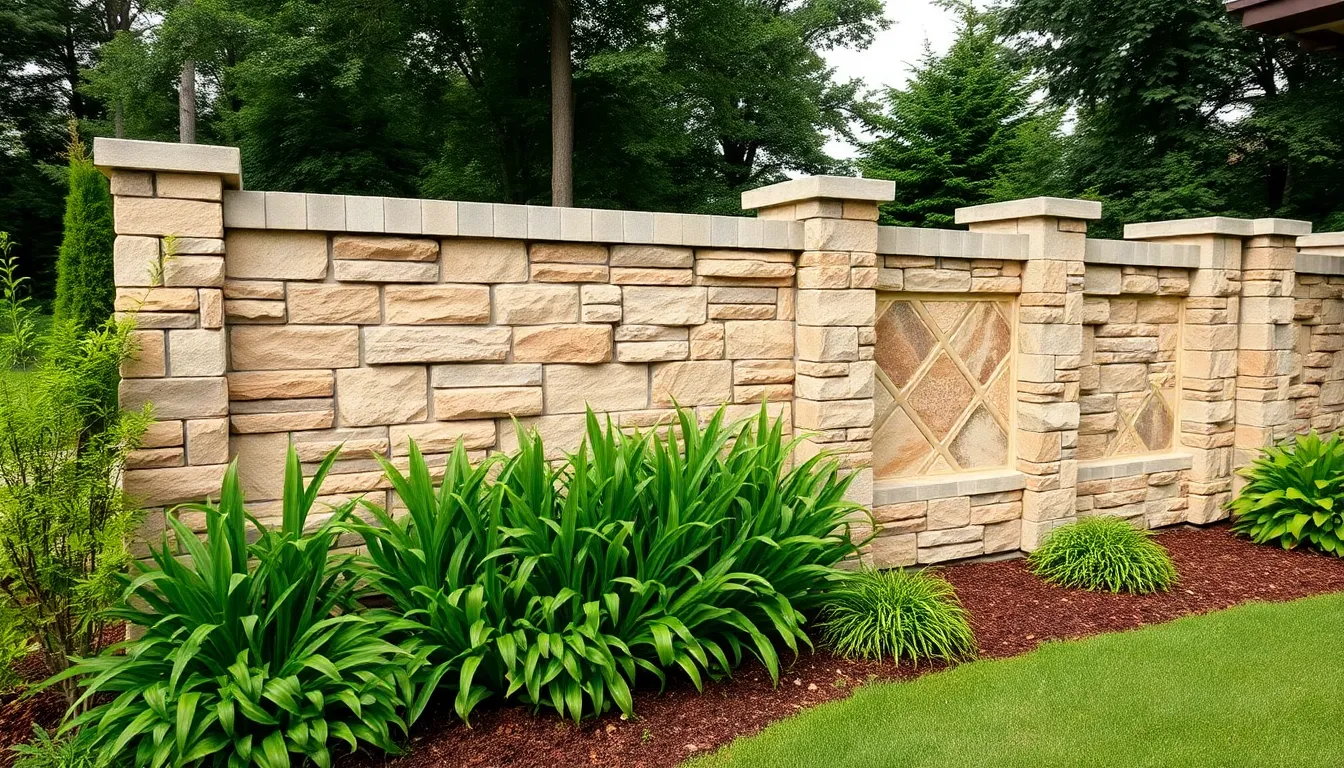
Stone and masonry options create permanent privacy answers that add substantial value to your garden space. These durable materials withstand weather conditions while providing excellent sound insulation and complete visual screening.
Natural Stone Retaining Walls
Natural stone walls deliver timeless elegance while offering superior privacy protection for your outdoor space. We recommend limestone, sandstone, or fieldstone varieties that blend seamlessly with garden landscapes and provide decades of maintenance-free service. Color variations in natural stone range from warm earth tones to cool grays, allowing you to customize the appearance to match your existing garden design.
Texture options include smooth-cut stones for modern aesthetics or rough-hewn varieties for rustic charm. Installation typically requires professional expertise due to proper foundation requirements and weight considerations. Height restrictions vary by local building codes, so we suggest checking regulations before planning walls over 6 feet tall.
Decorative Block Constructions
Decorative concrete blocks transform standard privacy walls into architectural features that enhance your garden’s visual appeal. We’ve seen impressive results with split-face blocks, textured surfaces, and geometric patterns that create shadow play throughout the day. Modern block designs include integrated planters, allowing you to incorporate greenery directly into the wall structure.
Color choices extend beyond traditional gray to include earth tones, warm browns, and even custom-tinted options. Screen block varieties feature open patterns that maintain airflow while providing partial privacy screening. Installation costs remain lower than natural stone while delivering comparable durability and longevity.
Mixed Material Combinations
Stone and wood combinations create stunning focal points that merge natural warmth with solid privacy protection. We recommend cedar or redwood inserts between stone pillars to add visual texture while maintaining structural integrity. Metal accents paired with stone bases deliver contemporary industrial aesthetics that complement modern garden designs.
Green wall integration transforms masonry structures into living privacy barriers by incorporating built-in planters or trellis systems. Vertical garden elements soften hard masonry lines while providing additional screening through plant growth. Maintenance requirements vary based on plant selections, with drought-resistant succulents offering low-maintenance options for busy homeowners.
Creative Vertical Garden Privacy Screens
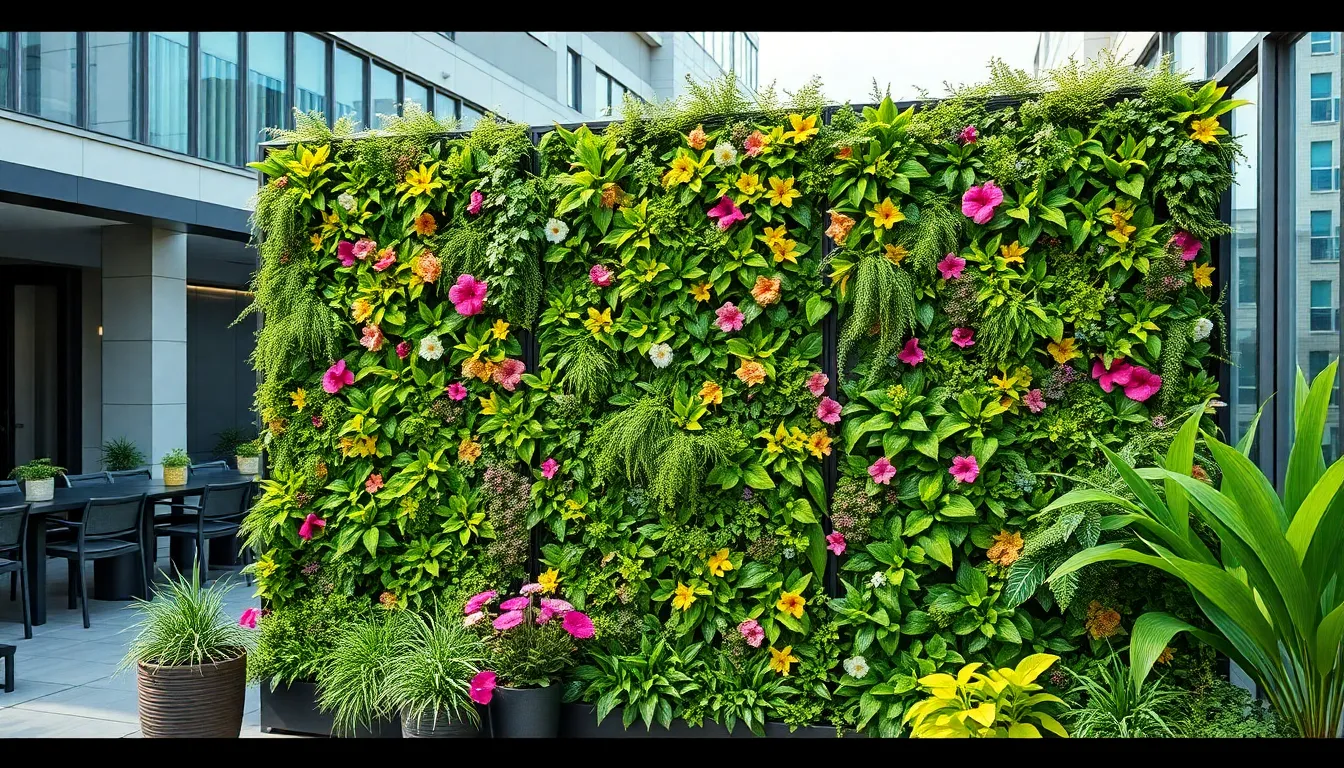
Creative vertical garden privacy screens transform ordinary barriers into living art installations that provide both seclusion and natural beauty. These innovative answers combine functionality with aesthetic appeal, incorporating plants and decorative elements to create stunning outdoor focal points.
Living Wall Systems
Living wall systems offer advanced vertical gardening answers that use modular panels to support diverse plant varieties. These sophisticated structures create impressive privacy barriers while improving air quality and establishing beneficial microclimates in your outdoor space.
Modular panel designs provide flexibility for customization, allowing you to adjust height and width according to your exact privacy needs. Systems can accommodate various plant types, from flowering perennials to leafy shrubs, creating year-round visual interest.
Installation requirements include proper irrigation systems and structural support to handle the weight of saturated soil and mature plants. Custom-built structures offer customized answers for unique garden layouts, while kit options provide accessible entry points for DIY enthusiasts.
Urban applications make living walls particularly valuable in compact spaces where traditional privacy fencing isn’t practical. These systems maximize vertical growing space while creating effective screening from neighboring properties.
Pallet Garden Fences
Pallet garden fences repurpose recycled wooden materials into budget-friendly privacy answers that add rustic charm to outdoor spaces. These eco-conscious barriers offer partial screening while serving as attractive garden dividers and plant supports.
Material preparation involves selecting sturdy pallets and treating them with weather-resistant finishes to extend durability. Paint applications can match existing garden color schemes, while natural wood stains preserve the authentic rustic appearance.
Planter integration transforms basic pallet structures into functional growing systems by attaching containers for herbs, flowers, or trailing plants. These additions enhance privacy coverage while creating productive garden elements.
Design flexibility allows for various configurations, from single pallet panels to extended fence runs that define garden boundaries. Spacing between slats provides ventilation and light penetration while maintaining visual separation.
Modular Planter Walls
Modular planter walls consist of stackable containers that create customizable living privacy barriers suitable for gardens of any size. These versatile systems offer easy installation and maintenance while providing complete design control over height, length, and plant selection.
Material options include wood, metal, and plastic containers, each offering distinct advantages for different garden conditions and aesthetic preferences. Cedar and redwood planters provide natural weather resistance, while metal options offer modern industrial appeal.
Plant selection encompasses perennials, annuals, and ornamental grasses that thrive in container environments. Combining different plant heights and textures creates ever-changing visual layers that enhance privacy effectiveness throughout growing seasons.
Installation advantages include no permanent ground modifications and easy reconfiguration as garden needs change. Interlocking designs ensure stability while allowing individual units to be moved or replaced without affecting the entire wall structure.
Budget-Friendly DIY Garden Privacy Ideas
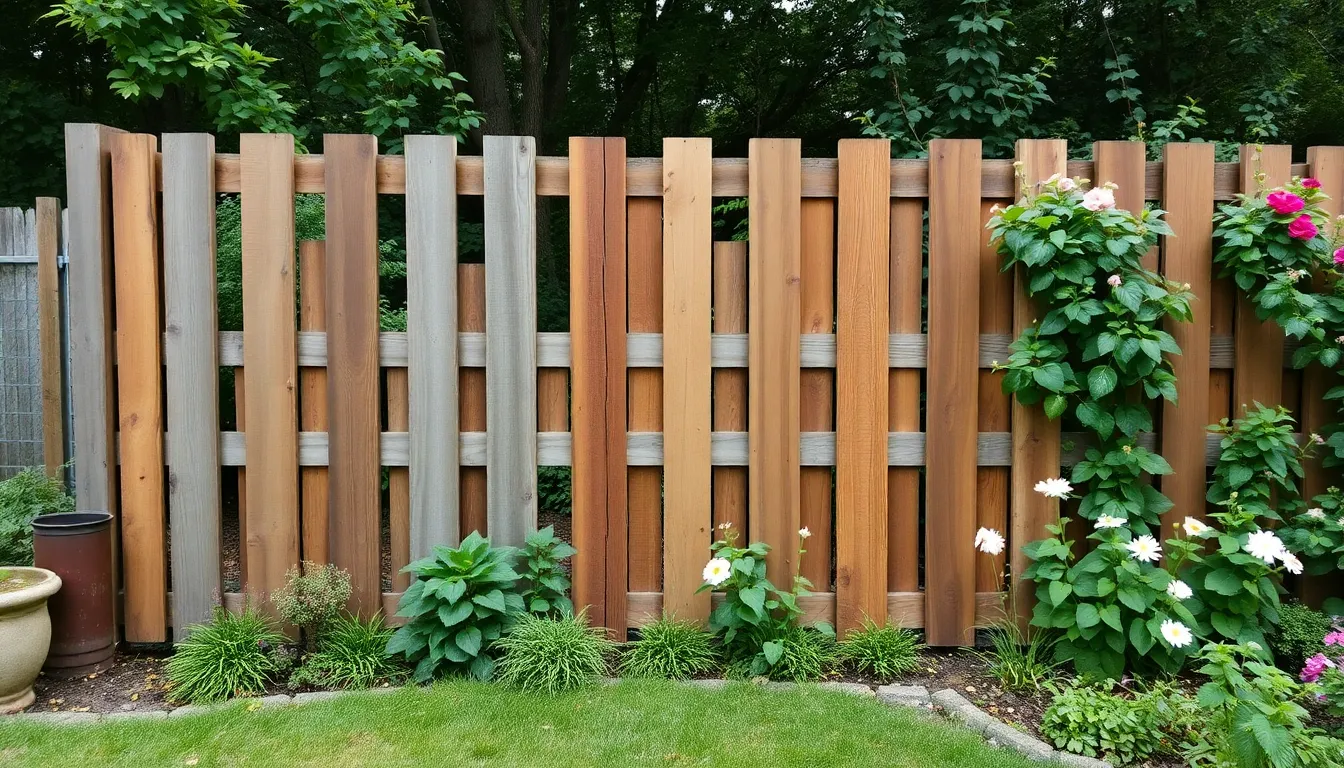
Creating privacy in your garden doesn’t require a massive budget when you embrace creative DIY answers. We’ve discovered that the most effective budget-friendly approaches often involve transforming everyday materials into functional privacy barriers.
Repurposed Material Fences
Pallet fence transformations offer incredible value by converting discarded shipping pallets into unique privacy dividers. We recommend painting or staining these pallets to match your garden theme, creating a customized look at a fraction of traditional fencing costs. Each pallet provides instant screening while maintaining that rustic charm many homeowners desire.
Steel conduit installations deliver country-modern aesthetics using inexpensive materials from any hardware store. We attach these lightweight conduits directly to existing deck structures or create standalone boundaries that resist weather damage. This approach works particularly well for contemporary gardens where clean lines matter most.
Wooden fence succulent gardens transform basic wooden panels into living privacy features by incorporating drought-tolerant plants directly into the fence structure. We drill strategic holes in fence boards and insert small succulents, creating visual interest while maintaining privacy coverage. This technique adds greenery without requiring additional ground space or extensive maintenance.
Simple Panel Construction
Horizontal slat fence panels provide the easiest DIY installation by using pre-fabricated components that attach to existing structures like chain link fencing. We secure these panels using metal brackets and cable ties, eliminating the need for complex carpentry skills. This method works especially well when you want to upgrade existing fencing without complete replacement.
Lattice privacy fence systems use pre-fabricated lattice sheets mounted on pressure-treated posts for classic screening that doesn’t feel enclosed. We space these panels strategically to maintain airflow while blocking unwanted views. The lattice pattern allows climbing plants to integrate naturally, creating dual purpose privacy barriers.
Bamboo slat fence construction incorporates sustainable materials that add tropical appeal to any garden space. We cut bamboo poles to desired lengths and secure them vertically or horizontally depending on your privacy needs. This eco-friendly option costs significantly less than traditional wood fencing while providing excellent screening density.
Temporary Screening Answers
Vertical garden privacy walls offer flexible screening perfect for renters or anyone wanting seasonal privacy adjustments. We install these living walls using modular panels that support various plant species while creating impressive privacy barriers. These systems can be easily relocated or removed without permanent industry changes.
Mesh fence plant combinations transform basic wire fencing into beautiful privacy screens by training climbing vines or roses along the mesh structure. We select fast-growing varieties like Virginia creeper or climbing roses that quickly establish dense coverage. This temporary approach allows seasonal adjustments while the plants mature into permanent privacy features.
DIY bug hotel fence art combines privacy screening with beneficial insect habitat creation using repurposed wood and plant containers. We construct these artistic barriers by layering different materials in fence-like structures that provide privacy while supporting garden network health. This approach serves dual purposes while maintaining budget-friendly construction costs.
Multi-Functional Privacy Fence Concepts
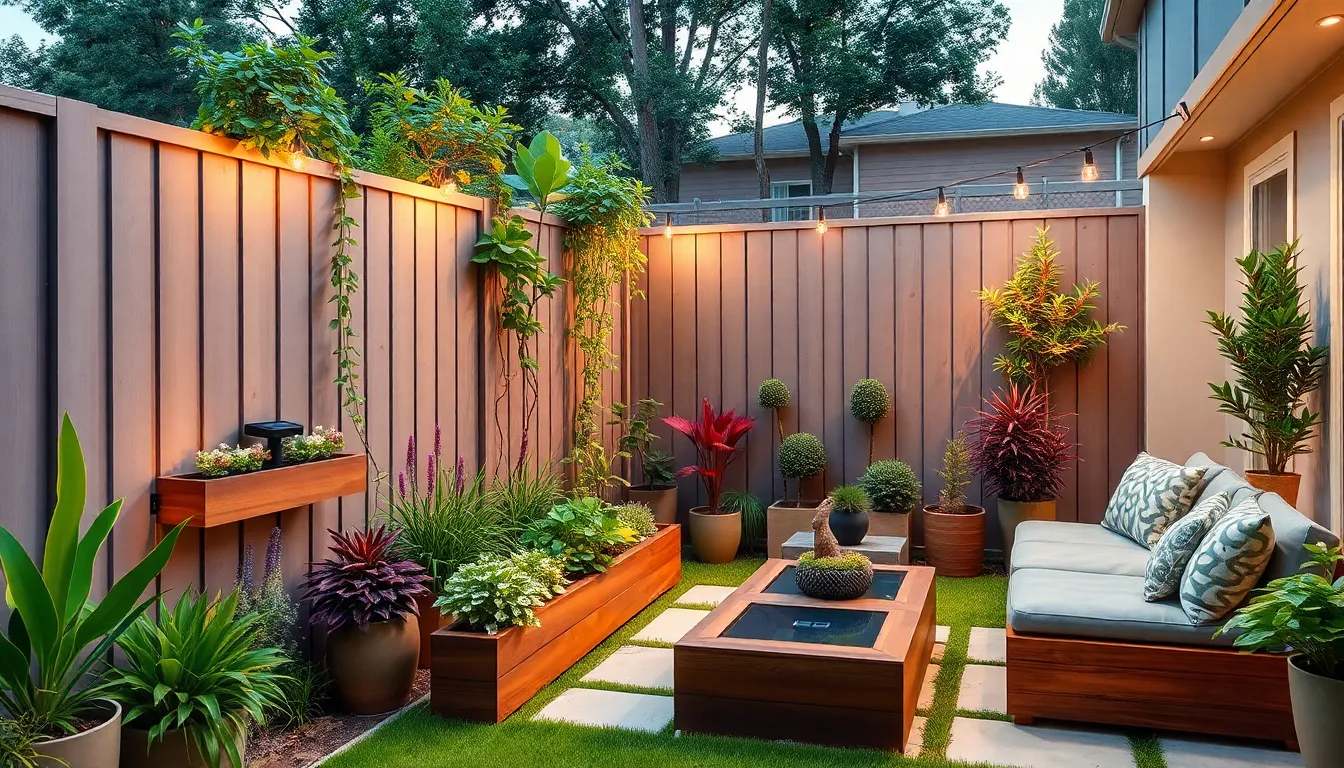
We’ve discovered that the most innovative privacy fences serve multiple purposes beyond blocking unwanted views. Smart design choices can transform ordinary barriers into functional features that maximize your outdoor space’s potential.
Storage Integration Features
Pallet fences with planters offer dual functionality by providing both privacy screening and organized garden storage space. These repurposed structures feature built-in compartments for storing small gardening tools, outdoor cushions, and seasonal decorations while supporting vibrant plant displays.
Lattice panels with hidden storage create clever concealment answers behind decorative screens. We recommend installing weather-resistant storage boxes or shelving systems directly behind lattice sections to keep garden supplies accessible yet completely invisible from neighboring properties.
Vertical garden privacy fences incorporate built-in planters that double as tool storage areas. These living walls feature integrated watering systems and small storage pockets for hand tools, making garden maintenance more efficient while maintaining complete privacy coverage.
Built-In Seating Options
Fence integrated benches transform property boundaries into comfortable outdoor seating areas without requiring additional square footage. These structures typically feature storage compartments beneath the seating surface for cushions, gardening supplies, or outdoor entertaining essentials.
Perimeter seating designs use existing fence lines as supportive backrest structures for custom built benches. We’ve found that cedar and composite materials work best for these applications, providing weather resistance and comfortable seating surfaces that complement various garden styles.
Multi-level seating systems incorporate stepped bench designs along fence lines to create amphitheater-style outdoor gathering spaces. These configurations work particularly well on sloped properties where traditional seating arrangements might prove challenging to install.
Lighting and Electrical Considerations
Solar powered lights integrate seamlessly into fence posts without requiring complex electrical installations or ongoing energy costs. Modern solar fence lighting systems provide 8-12 hours of illumination per charge and feature automatic dusk-to-dawn operation for consistent nighttime privacy and security.
LED strip lighting creates dramatic ambient effects when installed along horizontal fence slats or behind lattice panels. These energy-efficient systems consume 80% less electricity than traditional incandescent options while providing customizable color temperatures and dimming capabilities.
Integrated electrical outlets built into fence posts offer convenient power access for outdoor lighting, water features, or seasonal decorations. We suggest installing GFCI-protected outlets every 12-15 feet along fence lines to accommodate various electrical needs while maintaining safety standards and building code compliance.
Maintenance and Longevity Tips for Garden Privacy Fences
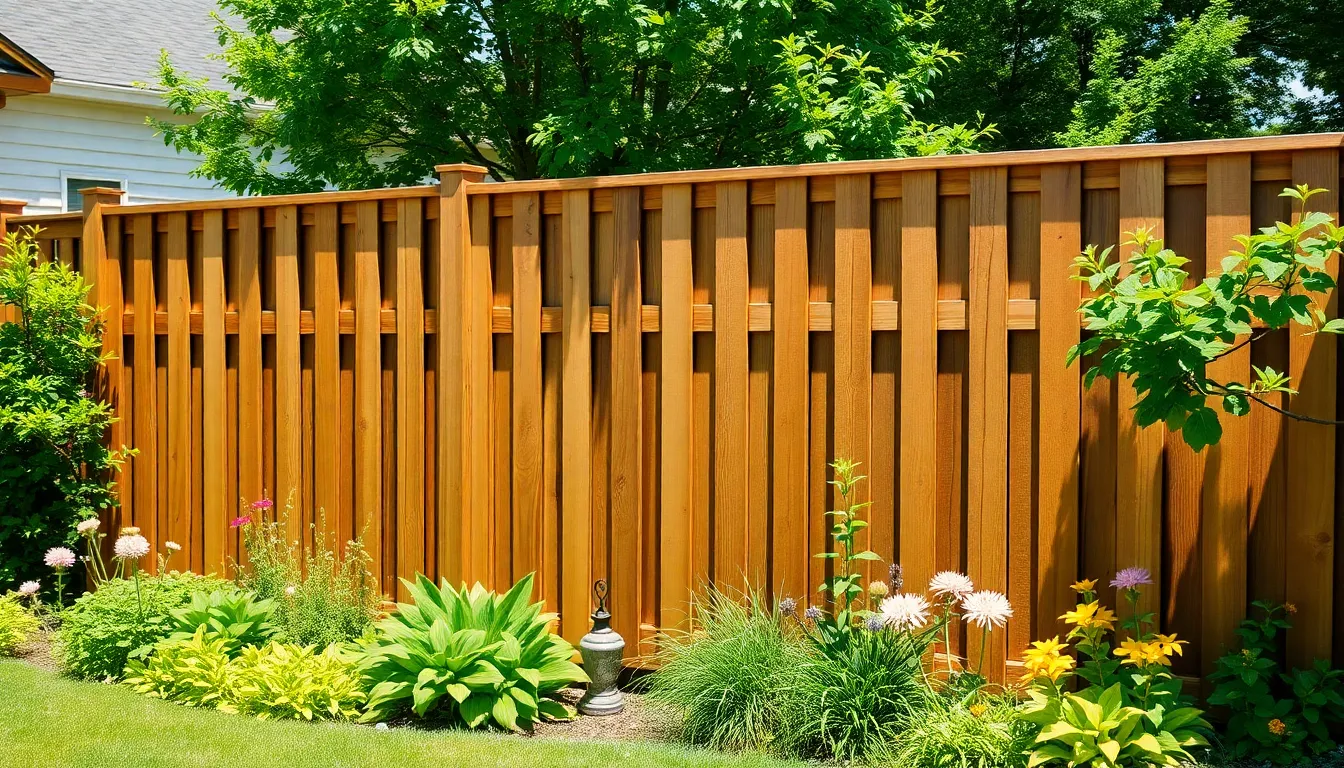
We’ve explored many privacy fence options, but choosing the right materials and understanding proper care requirements can make the difference between a fence that lasts decades versus one that needs replacement within a few years.
Weather-Resistant Materials
Metal privacy fences offer exceptional resistance to harsh weather conditions while requiring minimal ongoing maintenance. Corrugated metal fencing stands out as both budget-friendly and weather-resistant, making it an ideal choice for homeowners seeking durability without very costly.
Composite materials combine the natural appearance of wood with superior weather resistance. These engineered options resist moisture damage, UV degradation, and temperature fluctuations that commonly destroy traditional fencing materials.
Stone and brick constructions provide unmatched weather resistance for garden privacy walls. We recommend these masonry options for areas experiencing extreme weather patterns, as they naturally absorb sound while withstanding decades of environmental exposure.
Seasonal Care Requirements
Spring inspections should focus on identifying winter damage and preparing your fence for growing season maintenance. We suggest checking all connection points, cleaning accumulated debris, and addressing any structural issues before temperatures rise.
Summer maintenance varies significantly based on your fence material selection. Metal fences benefit from applying rust-resistant coatings during dry weather, while wooden structures require waterproof stain applications to prevent moisture penetration.
Fall preparation involves clearing vegetation growth from fence lines and ensuring proper drainage around posts. Regular cleaning removes organic matter that can trap moisture and accelerate deterioration during winter months.
Long-Term Durability Factors
Material selection directly impacts your fence’s lifespan and maintenance requirements over time. Stone and brick fences deliver the highest durability with minimal ongoing care, while bamboo and wood options require consistent maintenance to prevent rot and pest damage.
Foundation stability determines whether your privacy fence will remain structurally sound for decades. We recommend proper post installation with adequate concrete footings, especially for taller privacy screens that face increased wind loads.
Preventive care schedules extend fence life significantly when followed consistently. Regular damage inspections, immediate repair of minor issues, and proactive material treatments prevent small problems from becoming expensive replacements.
Conclusion
Creating your perfect garden privacy fence doesn’t have to be overwhelming when you understand your options. We’ve covered everything from natural bamboo screens to modern composite panels and multi-functional designs that maximize your outdoor space.
The key is matching your fence choice to your exact needs – whether that’s year-round screening with evergreen hedges or budget-friendly DIY answers using repurposed materials. Remember that proper maintenance and smart material selection will ensure your privacy investment lasts for years to come.
Your garden sanctuary awaits and with these ideas you’re well-equipped to transform any outdoor space into a private retreat that reflects your personal style while serving your practical needs.
Frequently Asked Questions
What are the best natural plants for creating privacy fences?
Clumping bamboo, evergreen hedges like arborvitae and boxwood, and fast-growing vines such as climbing roses and Virginia creeper are excellent natural privacy options. Bamboo provides dense screening quickly, evergreens offer year-round coverage, and climbing vines add color and fragrance while transforming existing fences into living barriers.
How can I create a modern-looking privacy fence?
Contemporary horizontal slat fences using cedar wood offer sleek aesthetics with natural rot resistance. You can also explore hybrid designs combining metal and wood, decorative lattice panels, or integrate climbing plants with lattice structures to create modern living privacy walls that blend style with function.
What are some budget-friendly DIY privacy fence ideas?
Pallet fences with built-in storage compartments, decorative lattice panels, and vertical garden screens using everyday materials are cost-effective options. These DIY solutions can transform barriers into functional storage areas while providing privacy and visual appeal without breaking the budget.
Which materials last longest for privacy fences?
Metal, composite, and masonry materials offer exceptional durability and weather resistance. These materials withstand harsh conditions better than traditional wood, requiring less maintenance over time. Cedar is also naturally rot and insect-resistant, making it a long-lasting wood option for privacy fencing.
How often should I maintain my privacy fence?
Conduct spring inspections for damage, perform summer maintenance like cleaning and minor repairs, and complete fall preparations to weatherproof your fence. Regular seasonal care prevents deterioration and extends fence lifespan. The maintenance frequency depends on your chosen materials and local weather conditions.
Can privacy fences serve multiple purposes?
Yes, modern privacy fences can integrate storage compartments, built-in seating, lighting systems, and electrical outlets. Multi-functional designs transform property boundaries into comfortable outdoor living areas while maximizing space efficiency and adding practical value beyond just blocking views.
What lighting options work best with privacy fences?
Solar-powered lights, LED strip lighting for ambient effects, and integrated electrical outlets in fence posts provide excellent illumination options. These lighting solutions enhance security, create atmosphere, and offer convenient power access for outdoor activities without requiring extensive electrical work.

